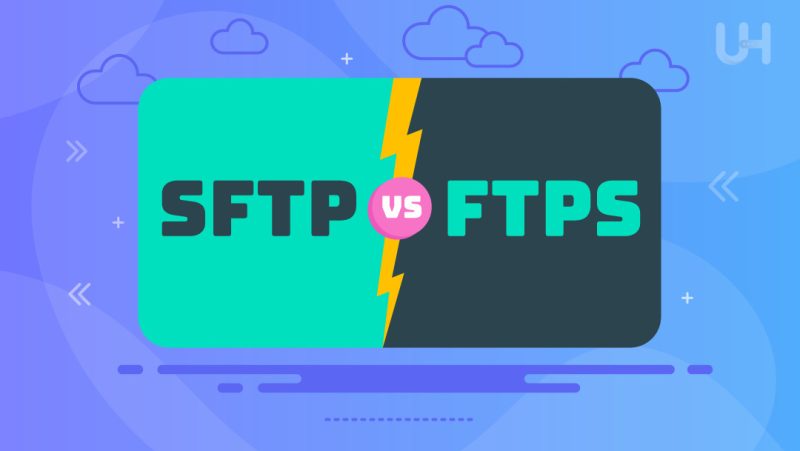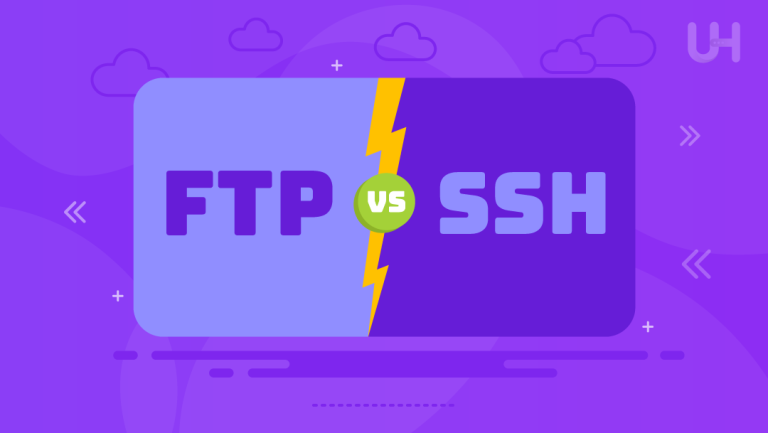Secure File Transfer Protocol (SFTP) and File Transfer Protocol Secure (FTPS) are two widely used protocols for transferring files over the internet securely. While both serve the same purpose of facilitating file transfer, they employ different mechanisms to ensure the security of data in transit.
In this blog we will compare FTPS vs SFTP in simple terms, looking at how they keep your files safe and which might be better for different situations. So, by the end, you’ll know which one might be best for you when you need to send files securely.
Understanding SFTP
SFTP, short for Secure File Transfer Protocol, is a way to securely exchange files between computers over a network. It’s like a special tunnel that keeps your files safe while they travel from one place to another. Unlike regular FTP, which sends files without encryption, SFTP encrypts everything, making sure that only the intended recipient can access the files.
How SFTP works
SFTP works by using a secure channel, usually over SSH (Secure Shell), to transfer files between a client and a server. When you want to send a file using SFTP, your computer first connects to the server through this secure channel. Then, it sends the file in encrypted form, so even if someone intercepts it, they can’t understand what it says. The server receives the encrypted file and decrypts it, storing it safely.
Key security features of SFTP
- Encryption mechanisms: SFTP uses strong encryption algorithms to scramble your files so that they’re unreadable to anyone who doesn’t have the right key to decrypt them. This ensures that even if someone manages to intercept your files while they’re being transferred, they won’t be able to make sense of them.
- Authentication methods: SFTP requires both the client and the server to prove their identities before exchanging any files. This can be done using passwords, public key authentication, or other methods. By verifying each other’s identities, SFTP ensures that only authorized users can access the files.
- Data integrity checks: SFTP includes mechanisms to check if the transferred files have been tampered with during transit. It uses hash functions to generate unique codes for each file, and these codes are compared at the receiving end to ensure that the file hasn’t been altered. If any changes are detected, SFTP alerts the user, preventing potential security breaches.
Understanding FTPS
FTPS, which stands for File Transfer Protocol Secure, is a secure version of the traditional FTP protocol. It adds an extra layer of security by incorporating SSL/TLS encryption, making it a preferred choice for transferring sensitive files over the internet. FTPS operates similarly to regular FTP but with added security features to protect data during transmission.
How FTPS works
FTPS establishes a secure connection between a client and a server using SSL/TLS encryption. When a file transfer is initiated, the client connects to the server and requests a secure connection. The server responds by presenting its digital certificate, which contains a public key. The client verifies the certificate’s authenticity and then generates a session key to encrypt the data. Once the secure connection is established, files can be transferred securely between the client and server.
Key security features of FTPS
- SSL/TLS encryption: One of the primary security features of FTPS is the use of SSL/TLS encryption to protect data during transmission. This encryption ensures that files transferred between the client and server are encrypted, making it extremely difficult for unauthorized parties to intercept and decipher the data.
- Authentication mechanisms: FTPS supports various authentication methods to verify the identities of both the client and server. This includes username/password authentication, public key authentication, and certificate-based authentication. By requiring authentication, FTPS ensures that only authorized users can access the files on the server.
- Server and client certificate usage: FTPS utilizes digital certificates to establish trust between the client and server. These certificates are issued by trusted certificate authorities and contain cryptographic keys used for encryption and authentication. The server presents its certificate to the client during the connection setup process, and the client verifies its authenticity before proceeding with the file transfer. Similarly, clients can also present certificates to servers for mutual authentication, further enhancing security.
Ready to Secure Your File Transfers?
Explore Ultahost’s SSH VPS services today for a robust and reliable solution. With powerful encryption and unparalleled performance, safeguard your data with ease. Get started now!
Security: Difference Between FTPS and SFTP
SFTP vs FTPS: Encryption Strength
SFTP and FTPS both employ strong encryption algorithms to protect data during transmission. However, they use different encryption mechanisms. SFTP typically uses the SSH protocol, which supports various encryption algorithms such as AES encryption, 3DES, and Blowfish. These algorithms provide robust encryption and ensure that data remains secure even if intercepted during transit. FTPS, on the other hand, utilizes SSL/TLS encryption, which also supports advanced encryption algorithms like AES, RC4, and DES. Both protocols offer similar levels of encryption strength, but the specific algorithms used may vary depending on the configuration.
Authentication Mechanisms
Authentication is a crucial aspect of secure file transfer protocols, as it verifies the identities of both the client and server. SFTP supports various authentication methods, including password-based authentication, public key authentication, and keyboard-interactive authentication. These methods offer flexibility and allow users to choose the most appropriate option based on their security requirements. FTPS also offers similar authentication mechanisms, including username/password authentication, public key authentication, and certificate-based authentication. Both protocols prioritize authentication to ensure that only authorized users can access the files.
Data Integrity
Data integrity ensures that files transferred between the client and server remain intact and unchanged during transit. SFTP and FTPS employ mechanisms to verify data integrity, but they differ in their approach. SFTP uses hash functions to generate unique checksums for each file before and after transfer. These checksums are compared to ensure that the file has not been tampered with.
FTPS, on the other hand, relies on SSL certificates to provide data integrity protection. The SSL/TLS protocol includes built-in mechanisms for ensuring data integrity, such as message authentication codes (MACs), which verify the integrity of transmitted data. Both SFTP and FTPS prioritize data privacy to prevent unauthorized modifications or alterations to files during transfer.
SFTP vs FTPS: Practical Considerations

SFTP vs FTPS: Performance
In terms of performance, both SFTP and FTPS can achieve similar transfer speeds under optimal conditions. However, there may be slight differences in performance depending on factors such as network latency, server load, and encryption overhead. SFTP tends to have slightly higher overhead due to its use of the SSH protocol, which includes additional encryption and authentication steps. FTPS, on the other hand, may experience slightly lower performance due to the overhead associated with SSL/TLS encryption.
Ease of Implementation
Setting up and configuring SFTP and FTPS can vary in complexity depending on various factors. Generally, SFTP is considered easier to implement because it typically only requires SSH access to the server and does not involve additional configuration for encryption and authentication. In contrast, FTPS may require more configuration steps, setting up user authentication, and configuring firewall settings to allow secure connections. However, with the availability of user-friendly FTPS server software and comprehensive documentation, the setup process can be streamlined for both protocols.
Compatibility
Both SFTP and FTPS enjoy broad compatibility with various operating systems and client software. SFTP is supported by most Unix-based systems, including Linux and macOS, as well as Windows server through third-party software or built-in support in some versions. FTPS, leveraging SSL/TLS encryption, is also widely supported across different platforms and client applications. However, it’s important to note that some older or more restricted environments may have limited support for FTPS due to firewall restrictions or outdated software versions.
Best Practices for Implementing SFTP and FTPS Securely
- Use Strong Authentication: Implement robust authentication mechanisms such as public key authentication or certificate-based authentication to verify the identities of both clients and servers. Avoid relying solely on password-based authentication, as it can be vulnerable to brute-force attacks.
- Regularly Update Software: Keep your SFTP and FTPS server software up-to-date with the latest security patches and updates. This helps address any known vulnerabilities and ensures that your file transfer system remains secure against potential exploits.
- Encrypt Data at Rest: In addition to encrypting data during transfer, consider encrypting data at rest on both the client and server sides. This provides an extra layer of protection, especially for sensitive files stored on disk.
- Implement Access Controls: Restrict access to your SFTP and FTPS servers by implementing granular access controls. Define user permissions based on the principle of least privilege, ensuring that users only have access to the files and directories necessary for their roles.
Tips for Optimizing Security and Performance
- Monitor Server Logs: Regularly monitor server logs for any suspicious activity, such as failed login attempts or unauthorized access attempts. Implement alerting mechanisms to notify administrators of any potential security incidents in real-time.
- Enable Firewall Rules: Configure firewall rules to restrict access to your SFTP and FTPS servers only to authorized IP addresses or networks. This helps mitigate the risk of unauthorized access from external sources.
- Implement Data Compression: Enable data compression where applicable to reduce the size of files transferred over the network. This can help improve transfer speeds and optimize bandwidth usage, especially for large files or bulk transfers.
- Regularly Backup Data: Implement regular backups of your files and server configurations to ensure data availability and disaster recovery. Store backups securely for disaster recovery to protect against data loss due to hardware failures, security breaches, or other unforeseen events.
Conclusion
In conclusion, the comparison between SFTP vs FTPS reveals two robust protocols, each with its strengths and considerations. SFTP, leveraging the SSH protocol, offers straightforward implementation and strong encryption, making it ideal for secure file transfer in various environments. On the other hand, FTPS provides compatibility with existing FTP infrastructure and comprehensive security features through SSL/TLS encryption.
Ultimately, the choice between SFTP or FTPS depends on specific security requirements, compatibility with existing systems, and ease of implementation.
For comprehensive website security and blazing-fast performance, discover our Cloudflare VPS hosting solutions. Protect your data and elevate your digital presence today.
FAQ
What is the primary difference between SFTP and FTPS?
The primary difference lies in their underlying protocols and encryption methods. SFTP operates over SSH (Secure Shell) and encrypts both authentication and data transfer, while FTPS extends the traditional FTP protocol with SSL/TLS encryption for data protection.
Which protocol is more secure, SFTP, or FTPS?
Both SFTP and FTPS offer strong security features, including encryption and authentication mechanisms. The choice between them often depends on specific requirements and compatibility with existing systems.
Can I use SFTP or FTPS on any operating system?
Yes, both SFTP and FTPS are supported on various operating systems, including Linux, macOS, and Windows. However, compatibility may vary depending on the availability of client software and configuration options.
Are there any performance differences between SFTP and FTPS?
While both protocols can achieve similar transfer speeds under optimal conditions, slight performance differences may occur due to factors such as network latency and encryption overhead. In practice, the performance impact is often negligible for most users.











